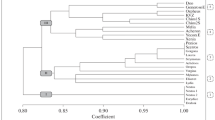Abstract
Durum wheat is an important crop, whose grain is used for the production of pasta, bread, couscous, bulgur, and other products. The end-use of wheat is heavily determined by the grain’s characteristics, which depend on the wheat variety, the environmental effects, and genotype–environment interactions. In Tunisia, ancient durum wheat varieties disappeared and they were replaced by other new breeding programs. Modern Tunisian durum wheat varieties were collected from different zones throughout the country. The wheat varieties were evaluated for various chemical and technological quality parameters. Results of quality characteristics of the examined wheat grains showed a strong influence of the growing zone on almost all analytical parameters. These differences between wheat varieties may be ascribed to the differences between the genotype–environment interaction such as soil, climate, and the use of fertilizers, etc.
Access this chapter
Tax calculation will be finalised at checkout
Purchases are for personal use only
Similar content being viewed by others
References
Abu Hammad, W.A., Elias, E.M., Manthey, F.A., Alamri, M.S., Mergoum, M.: A comparison of methods for assessing dough and gluten strength of durum wheat and their relationship to pasta cooking quality. Int. J. Food Sci. Technol. 47(12), 2561–2573 (2012)
Anderson, J.W., Hanna, T.J., Peng, X., Kryscio, R.J.: Whole grain foods and heart disease risk. J. Am. College Nutrit. 19, 291–299 (2000)
Dexter, J.E., Tkachuk, R., Tipples, K.H.: Physical properties and processing quality of durum wheat fractions recovered from a specific gravity table. Cereal Chem. 68, 401–405 (1991)
Gooding, M.J., Davies, W.P.: Wheat Production and Utilization: Systems. Quality and the Environment. CAB Int, Wallingford (1997)
Halverson, J., L. Zeleny.: Criteria of wheat quality. In: Pomeranz, Y. (ed.) Wheat Chemistry & Tech, pp 15–46. American Association of Cereal Chemist. Inc., St. Paul, MN (1988)
Liu, S., Manson, J.E., Stampfer, M.J., Hu, F.B., Giovannucci, E., Colditz, G.A., Hennekens, C.H., Willett, W.C.: A prospective study of whole grain intake and risk of type 2 diabetes mellitus in US women. Am. J. Public Health 90, 1409–1415 (2000)
Nicodemus, K.K., Jacobs, D.R.J., Folsom, A.R.: Whole and refined grain intake and risk of incident postmenopausal breast cancer. Cancer Causes Control 12, 917–925 (2001)
Ouzouline, M., Tahani, N., Elamrani, A., Serghini, C.H.: Comparaison de la composition lipidique de grains de blé dur et blé tender de variétés marocaines. Les technologies de laboratoire 15, 9–15 (2009)
Rharrabti, Y., Elhani, S., Martos-Nunez, V., Luis, F., Del Moral, G.: Protein and lysine content, grain yield, and other technological traits in durum wheat under mediterranean conditions. J. Agric. Food Chem. 49, 3802–3807 (2001)
Yesli, A., Latati, M., Tellah, S., Abdellaoui, Z., Ounane, G.: Physicochemical and rheological properties and bread-making potential of durum flour and semolina Journal of Food. Agric. Environ. 15(2), 14–20 (2017)
Kim M.J., Yoon W.J., Kim S.S.: Phytochemical compositions of immature wheat bran, and its antioxidant capacity, cell growth inhibition, and apoptosis induction through tumor suppressor gene. Molecules 21, 1292 13 p (2016)
Author information
Authors and Affiliations
Corresponding author
Editor information
Editors and Affiliations
Rights and permissions
Copyright information
© 2021 The Editor(s) (if applicable) and The Author(s), under exclusive license to Springer Nature Switzerland AG
About this paper
Cite this paper
Manai-Djebali, H., Baccouri, B., Oueslati, I., Harzalli, Z., Ghorbel, A. (2021). Tunisian Durum Wheat Varieties: Influence of Geographical Origin. In: Ksibi, M., et al. Recent Advances in Environmental Science from the Euro-Mediterranean and Surrounding Regions (2nd Edition). EMCEI 2019. Environmental Science and Engineering(). Springer, Cham. https://doi.org/10.1007/978-3-030-51210-1_188
Download citation
DOI: https://doi.org/10.1007/978-3-030-51210-1_188
Published:
Publisher Name: Springer, Cham
Print ISBN: 978-3-030-51209-5
Online ISBN: 978-3-030-51210-1
eBook Packages: Earth and Environmental ScienceEarth and Environmental Science (R0)




